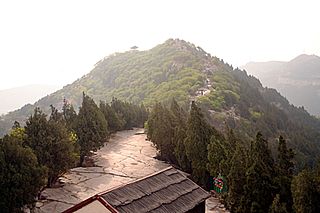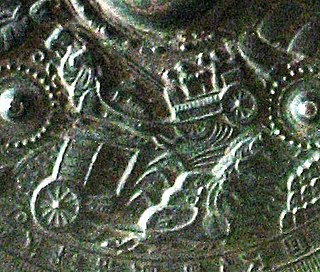
The history of North Korea began at the end of World War II in 1945. The surrender of Japan led to the division of Korea at the 38th parallel, with the Soviet Union occupying the north, and the United States occupying the south. The Soviet Union and the United States failed to agree on a way to unify the country, and in 1948 they established two separate governments – the Soviet-aligned Democratic People's Republic of Korea and the Western-aligned Republic of Korea – each claiming to be the legitimate government of all of Korea.

Paektu Mountain, also known as Baekdu Mountain and in China as Changbai Mountain, is an active stratovolcano on the Chinese–North Korean border. At 2,744 m (9,003 ft), it is the highest mountain of the Changbai and Baekdudaegan ranges. Koreans assign a mythical quality to the volcano and its caldera lake, considering it to be their country's spiritual home. It is the highest mountain in North Korea, the Korean Peninsula and Northeast China.

The contemporary culture of North Korea is based on traditional Korean culture, but has developed since the establishment of the Democratic People's Republic in 1948.

The practice of Christianity in Korea revolves around two of its largest branches, Protestantism and Catholicism, accounting for 8.6 million and 5.3 million members, respectively. Catholicism was first introduced during the late Joseon Dynasty period by Confucian scholars who encountered it in China. In 1603, Yi Gwang-jeong, Korean diplomat, returned from Beijing carrying several theological books written by Matteo Ricci, an Italian Jesuit missionary to China. He began disseminating the information in the books, and the first seeds of Christianity were sown. In 1758, King Yeongjo of Joseon officially outlawed Catholicism as an "evil practice." Catholicism was again introduced in 1785 by Yi Seung-hun and since then French and Chinese Catholic priests were invited by the Korean Christians.

The Pyongyang Metro is the rapid transit system in the North Korean capital Pyongyang. It consists of two lines: the Chollima Line, which runs north from Puhŭng Station on the banks of the Taedong River to Pulgŭnbyŏl Station, and the Hyŏksin Line, which runs from Kwangbok Station in the southwest to Ragwŏn Station in the northeast. The two lines intersect at Chŏnu Station.
Li, also known as the Chinese mile, is a traditional Chinese unit of distance. The li has varied considerably over time but was usually about one third of an English mile and now has a standardized length of a half-kilometer. This is then divided into 1,500 chi or "Chinese feet".

The population of Koreans in China include millions of descendants of Korean immigrants with citizenship of the People's Republic of China, as well as smaller groups of South and North Korean expatriates, with a total of roughly 2.3 million people as of 2009, making it the largest ethnic Korean population living outside the Korean Peninsula.

The Thousand Buddha Mountain is a hill located about 2.5 kilometers southeast of the city of Jinan, the capital of Shandong Province, China. It covers 1.518 square kilometers and has a peak of 285 meters above sea level. It is renowned for its numerous Buddha images which have been carved out of the hill's rock faces or free-standing structures erect since the times of the Sui Dynasty (581-618) and its Xingguochan Temple. It is considered as one of the "Three Greatest Attractions in Jinan" together with Baotu Spring and Daming Lake. It is also one of the 4A-rated Tourist attractions in China. Thousand Buddha Mountain is opened up as a public park in 1959, rated as AAAA-rated Tourist Attractions of China in 2005, and rated as National Park of China in March 2017.

Kim Tu-bong was the first Chairman of the Workers' Party of North Korea from 1946 to 1949. He was known in Korean history as a linguist, scholar and politician. His most famous work was under Ju Sigyeong; later, after participating in the March 1st Movement, he with other Korean leaders of the time established a provisional government-in-exile in China, and because of his communist beliefs he played an important role in the early North Korean communist government.

Wani is a semi-legendary Korean scholar who is said to have been sent to Japan by Baekje of southwestern Korea during the reign of Emperor Ōjin. He used to be associated with the introduction of the Chinese writing system to Japan.

The Chollima Movement (Korean: 천리마운동) was a state-sponsored Stakhanovite movement in North Korea intended to promote rapid economic development. Launched in 1956 or 1958, the movement emphasized "ideological incentives to work harder" and the personal guidance of Kim Il-sung rather than rational modes of economic management.

Kim Il-sung was the founder and first Supreme Leader of North Korea, which he ruled from the country's establishment in 1948 until his death in 1994. He held the posts of Premier from 1948 to 1972 and President from 1972 to 1994. He was also the leader of the Workers' Party of Korea (WPK) from 1949 to 1994. Coming to power after the end of Japanese rule in 1945, he authorized the invasion of South Korea in 1950, triggering an intervention in defense of South Korea by the United Nations led by the United States. Following the military stalemate in the Korean War, a ceasefire was signed on 27 July 1953. He was the third longest-serving non-royal head of state/government in the 20th century, in office for more than 45 years.

Horses in East Asian warfare are inextricably linked with the strategic and tactical evolution of armed conflict. A warrior on horseback or horse-drawn chariot changed the balance of power between civilizations.

The Mansudae Art Studio is an art studio in Pyeongcheon District, Pyongyang, North Korea. It was founded in 1959, and it is one of the largest centers of art production in the world, at an area of over 120,000 square meters. The studio employs around 4,000 people, 1,000 of whom are artists picked from the best academies in North Korea. Most of its artists are graduates of Pyongyang University. The studio consists of 13 groups, including those for woodcuts, charcoal drawings, ceramics, embroidery and jewel paintings, among other things. The studio has produced many of North Korea's most important monuments, such as the Monument to the Founding of the Korean Workers Party, the Chollima Statue, and the Mansu Hill Grand Monument. Its foreign commercial division is known as the Mansudae Overseas Project Group of Companies, which as of 2014 has created monuments for 18 African and Asian nations. All images of the Kim family are produced by the Mansudae Art Studio. Before his death, the Mansudae Art Studio was under the guidance of Kim Jong-il. Since 2009, the studio has had its own space also in the 798 Art District in Beijing, China, known as the Mansudae Art Museum.
Bole (Po-le; simplified Chinese: 伯乐; traditional Chinese: 伯樂; pinyin: Bólè; Wade–Giles: Po2-le4) or Bo Le was a horse tamer in Spring and Autumn period, and the honorific name of Sun Yang (simplified Chinese: 孙阳; traditional Chinese: 孫陽; pinyin: Sūn Yáng; Wade–Giles: Sun1 Yang2), who was a retainer of Duke Mu of Qin (r. 659-621 BCE) and a famous judge of horses. Bole was the legendary inventor of equine physiognomy ("judging a horse's qualities from appearance").

Korean nationalist historiography is a way of writing Korean history that centers on the Korean minjok, an ethnically or racially defined Korean nation. This kind of historiography emerged in the early twentieth century among Korean intellectuals who wanted to foster national consciousness to achieve Korean independence from Japanese domination. Its first proponent was journalist and independence activist Shin Chaeho (1880–1936). In his polemical New Reading of History, which was published in 1908 three years after Korea became a Japanese protectorate, Shin proclaimed that Korean history was the history of the Korean minjok, a distinct race descended from the god Dangun that had once controlled not only the Korean peninsula but also large parts of Manchuria. Nationalist historians made expansive claims to the territory of these ancient "Korean" kingdoms, by which the present state of the minjok was to be judged.

Chinese writing, culture and institutions were imported as a whole by Vietnam, Korea, Japan and other neighbouring states over an extended period. Chinese Buddhism spread over East Asia between the 2nd and 5th centuries AD, followed by Confucianism as these countries developed strong central governments modelled on Chinese institutions. In Vietnam and Korea, and for a shorter time in Japan and the Ryukyus, scholar-officials were selected using examinations on the Confucian classics modelled on the Chinese civil service examinations. Shared familiarity with the Chinese classics and Confucian values provided a common framework for intellectuals and ruling elites across the region. All of this was based on the use of Literary Chinese, which became the medium of scholarship and government across the region. Although each of these countries developed vernacular writing systems and used them for popular literature, they continued to use Chinese for all formal writing until it was swept away by rising nationalism around the end of the 19th century.
The People's Prize is a North Korean arts and sciences award. It is awarded by the People's Prize Awarding Commission, which is working directly under the Cabinet of North Korea. The prize can be granted to works of art or people. People's Prize has been an important award in the field of North Korean cinema.

The Chollima Statue is a monument on Mansu Hill in Pyongyang, the capital of North Korea. The monument symbolizes the "Chollima speed" of the Chollima Movement. The legendary winged horse Chollima depicted by the monument is said to travel 1,000 ri (400 km) a day.
Korean units of measurement, called cheokgwan-beop or cheokgeun-beop in Korean, is the traditional system of measurement used by the people of the Korean peninsula. It is largely based on the Chinese system, with influence from Japanese standards imposed following its annexation of the Korean Empire in 1910. Both North and South Korea currently employ the metric system. Since 2007, South Korea has criminalized the use of Korean units in commercial contexts but informal use continues, especially of the pyeong as a measure of residential and commercial floorspace. North Korea continues to use the traditional units, although their standards are now derived from metric conversions.
















